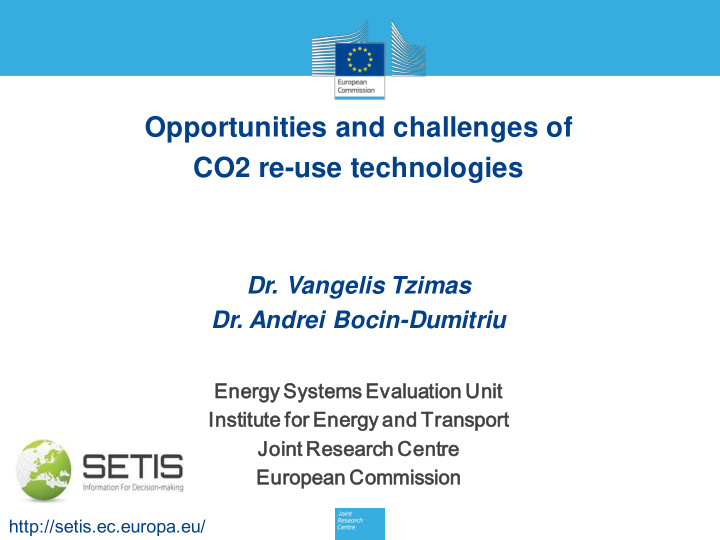



Opportunities and challenges of CO2 re-use technologies Dr. Vangelis Tzimas Dr. Andrei Bocin-Dumitriu Energy ergy System ems Evalua aluation ion Unit nit Instit itute e for or Energy ergy and d Trans ansport port Joint int Res esearc earch h Cent ntre re Europe ropean an Com ommis ission ion http://setis.ec.europa.eu/
The opportunity of CO2 re-use technologies A key to demonstration and large-scale deployment of CCS in power plants and the energy-intensive industry • Offset the high costs of CCS by offering feedstock for other production processes (hydrocarbons, chemicals, synthetic fuels, etc.) • Provide a substitute for geological storage – allow for further CO2 capture innovations and help addressing public acceptance issues Addressed by energy technology and R&I policies, focusing on technology options with potential of significant net CO2 emission reductions • Potential recognised in the Consultative Communication 'The future of CCS in Europe' COM(2013)180 • R&D activities currently included in the draft 2013-2015 Implementation Plan of the CCS-EII
Current status of CO2 re-use CO2 has already been successfully utilised for: • EOR • Urea • Refrigerants • Beverages • Welding systems • Fire extinguishers • Water treatment processes • Horticulture • Precipitated calcium carbonate for the paper industry • Food packaging
A wide portfolio of technology options CSLF , 2012 Source: CSLF’s CO2 Utilisation Options Task Force Phase 1 Report (2012)
The challenge of CO2 re-use technologies • Most still at R&D stage • Energy efficiency losses • Higher production costs • Limited financial incentives • Limited CO2 uptake / storage potential compared to anthropogenic emissions • More complex value chain
Commercialisation of CO2 re-use technologies Source: GCCSI/Parsons&Brinckerhoff report 2011
Overview of technology pathways Research & Industrial CO2 re-use technology Uptake potential (Mt/y) TRLs engagement Further investigations: DG JRC This workshop 2-4 + + + Methanol production > 300 + + + (Carbonate) Mineralisation > 300 3-6 + + + Polymerisation 5 < demand < 30 8-9 2-4 + + + Formic acid > 300 5 < demand < 30 + + + Urea 9 + - - Enhanced coal bed methane recovery 30< demand < 300 6 + + - Enhanced geothermal systems 5 < demand < 30 4 > 300 + - - Algae cultivation 3-5 + + - Concrete curing 30< demand < 300 4-6 + + - Bauxite residue treatment 5 < demand < 30 4-5 >300 + + - Fuels engineered micro-organism 2-4 + - - CO2 injection to methanol synthesis 1<demand<5 2-4 + - - Graphene** ~ 224 (not an annual figure) 1-3
Status of promising technology options Polymerisation mineralisation Formic acid (Carbonate) production Methanol Urea Criterion Technology maturity Scale-up potential Commercial viability CO2 abatement potential Based on GCCSI/Parsons&Brinckerhoff 2011
Knowledge gaps Decision makers should rely on scientific assessments of the various technology options, focused on: • Energy balance • Cost effectiveness • CO2 budget • Duration of storage • Availability of other needed compounds (e.g. H2) • Impact on markets and other industrial sectors • Identification of bottlenecks (technological, market, regulatory) These issues are addressed in a thorough techno- economic analysis undertaken by the JRC
Thank you! evangelos.tzimas@ec.europa.eu Please visit the SETIS website: http://setis.ec.europa.eu
Recommend
More recommend